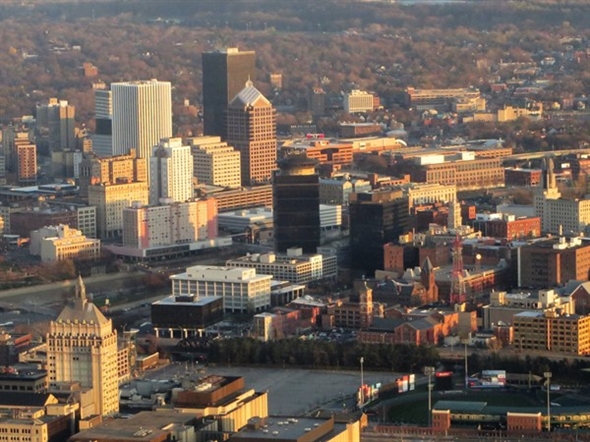Why Clean Energy Needs to Be a Part of Greater Rochester’s Economic Development

A great deal of attention in Upstate and Western New York is given to economic development, and rightly so. In this period of climate disruption, water scarcity, and habitat loss, the region offers enormous potential. Famously, it’s adjacent to more than 20% of the world’s fresh water (the Great Lakes are the largest group of freshwater lakes on Earth by total area and are the second-largest by total volume, containing 21% of the world’s surface fresh water). It has rich and fertile soils, a substantial growing season, significant infrastructure, and a history of economic prosperity.
But it’s equally important that this growing economic development incorporate the realities of the 21st century in its planning. The world is in a race to stave off the worst effects of climate change by reducing greenhouse gas emissions, preventing further biodiversity loss, and restoring ecosystems. According to the latest IPCC report, “limiting warming to around 1.5°C (2.7°F) requires global greenhouse gas emissions to peak before 2025 at the latest, and be reduced by 43% by 2030.” Emissions must peak before 2025: just let that sink in; along with the fact that 2021’s emissions were the highest ever, more than reversing the pandemic’s reductions in 2020.
The point, however, is not simply to recognize the magnitude of the challenge; it’s also to make sure that we don’t lock in further harm by failing to make all new development as green as possible and saddling the region with more stranded assets. The following comments were submitted to the region’s key economic development leaders in mid-February, and we’re waiting for a response. Meanwhile, we’ll be talking with economic development organizations in Buffalo, which appear to have a greater interest in sustainable development.
On January 27 the Rochester Business Journal hosted a webinar with the region’s three key leaders in local economic development, Matt Hurlbutt of Greater Rochester Enterprise, Baye Muhammad of REDCO, and Vincent Esposito of Empire State Development Corporation. an agency of the New York State government. The webinar was excellent and demonstrates what effective collaboration can accomplish.
There was at least one element missing, however, and that’s ensuring that all development and redevelopment from this point forward is as “green” as possible. We need to cut back on greenhouse gas emissions, and the best place to start is with all new construction or reconstruction. Fortunately, we have some useful tools to do this. What we need is an effective joint communications strategy and plan.
The City of Rochester, Monroe County, the State of New York, and the federal government all have Climate Action objectives which call for 40-55% reductions in emissions by 2030. Buildings account for about 40% of all emissions, and in urban areas, commercial and industrial buildings account for 75% of these emissions.
Cutting back on these emissions is harder to do than switching to electric vehicles and utility-scale cleaner energy generation. Because each building is unique, often operates independently, and is privately owned, only a program like C-PACE can hope to address the need for system-wide upgrades. To start with, we need to stop burning fossil fuels in buildings. This means electrification (and perhaps biogas or hydrogen). and in most cases retrofits of existing buildings. This is what C-PACE was designed for.
But it makes no sense to continue building buildings that are going to need to be retrofitted for new systems in a decade or less. We need to switch now to building all-electric buildings, that operate on clean energy, and ideally ones capable of absorbing rather than releasing CO2 into the atmosphere. This is why C-PACE needs to be an integral part of the economic development toolkit.
Bringing C-PACE investment to our metropolitan area means building better buildings, building smarter and more forward-looking buildings, and being part of the solution rather than part of the problem. As well as being in the midst of economic renewal we are also in a period of economic transition, moving from a primarily extractive economy into a more regenerative and self-sustaining economy, and better buildings are a part of this. In most cases, they’re also superior from an operating standpoint, from a cost-saving standpoint, and from an asset-quality and asset-value standpoint. And C-PACE can have a positive impact on distressed and disadvantaged communities, offering significant capital for retrofits and new construction.
The tools we can use include:
- C-PACE (100% financing for existing buildings, and 20-30% of capital stack for new construction)
- More than 30 NYSERDA incentives
- Federal Tax Credits of 26% for solar (this year) plus accelerated depreciation (MACRS)
- Membership in the Building Decarbonization Coalition
- Access to additional private investment capital
- Federal $200,000 Grant for Nonprofits
Our organization, Possible Rochester, is the initiative of a 501(c)(3) nonprofit corporation focused on clean energy finance in the Northeast since 2013. Jonathan Cloud, the group’s Executive Director, writes:
We welcome the opportunity for dialogue as to the best way for us to partner in this economic development opportunity—which can make available hundreds of millions in private investment, buy-local programs, job creation, energy savings for property owners, and growth for clean energy contractors. We’re ready to be a partner in economic development as one element of a comprehensive and integrated strategy, which we know is what the region needs and wants.
In addition to the cost savings and emissions reductions, expanding C-PACE and other clean energy improvements can help build the “green jobs” sector in the region. This is an area where the legacy of technological innovation can also be relevant, as new solutions are required that draw down carbon as well as simply cutting emissions. Much more on this to come… and thanks for reading.

